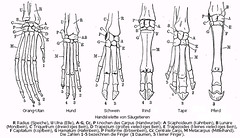![]()
![]()
![]()
Use LEFT and RIGHT arrow keys to navigate between flashcards;
Use UP and DOWN arrow keys to flip the card;
H to show hint;
A reads text to speech;
15 Cards in this Set
- Front
- Back
|
Arthropod characteristics:
Describe arthropod exoskeleton, body structure, and appendages |
Arthropod characteristics:
1. Pliable or sclerotized body of chitin 2. Segmented - segments can be grouped into tagmata 3. Jointed appendages |
|
|
Arthropod characteristics:
How do Arthropods grow? Why is this important to them? |
Arthropod characteristics:
Arthropods grow by ecdysis- growth by molting. This is important because their exoskeleton does not change. |
|
|
Arthropod characteristics:
How do Arthropods sense their surroundings? How do they view their environment? |
Arthropod characteristics:
1. Setae - cuticle modifications as sensors 2. Compound eyes and ocelli (little eyes) |
|
|
Arthropod characteristics:
What type of circulatory system do Arthropods have? What are they filled with? |
Arthropod characteristics:
1. Have an open circulatory system 2. Organs are located in Hemocoel filled with hemolymph |
|
|
Arthropod characteristics:
How do Arthropods breath? |
Arthropod characteristics:
1. Tracheal system in terrestrial arthropods 2. Utilize spiracles (holes in exoskeleton) to take in oxygen |
|
|
Arthropod characteristics:
How do Arthropods digest? |
Malpighian tubules function as the small intestine |
|
|
Chelicerata characteristics:
How many appendages? What do they use to pinch? Sense? What do they lack? Distinct structure? |
Chelicerata characteristics:
1. Six pairs 2. Chelicerae (pincers) 3. Pedipalps (sensory) 4. Lack antennae and mandibles 5. Prosoma ad opisthoma |
|
|
Crustacea characteristics:
How many antennae? Type of limbs? |
Crustacea characteristics:
1. Two pairs 2. Biramous |
|
|
Myriapoda characteristics:
How many antennae? Special characteristics? Segmentation? Segmentation difference in classes? |
Myriapoda characteristics:
1. One pair 2. Mandibles and uniramous limbs 3. No clear tagmata (segments) 4. Diplopoda - 2 pair legs per segment Chilopoda - 1 pair legs per segment |
|
|
Hexapoda characteristics:
How many antennae? Segmentation? |

Hexapoda characteristics:
1. One pair 2. Three distinct tagmata
|
|

Phylogenetics:
Phylogenetic trees are based on ___________? |
Phylogenetics:
Synapomorphies - shared derived traits
Derived traits - traits have changed from its ancestral trait |
|
|
Phylogenetics:
Phylogenetic trees are constructed based on what principle? |
Phylogenetics:
Principle of parsimony - the simplest tree is the best |
|

Phylogenetics:
What is homology? Where can it be seen? Example? |
Phylogenetics:
1. Traits that are derived from the same ancestral trait 2. Embryonic development (Hox genes) 3. Arm bone structure in humans, cat, whale |
|

Phylogenetics:
What is homoplasy? Why does this happen? Example? |
Phylogenetics:
1. Traits that are similar not due to common ancestry 2. Convergent evolution or evolutionary reversals 3. Convergent evolution - Australian marsupials, Reversal - Urchin and starfish radial symmetry |
|

Phylogenetics:
What is a monophyletic group? Paraphyletic? Polyphyletic? |
Phylogenetics:
1. Common ancestor and all descendents 2. Common ancestor and some descendents but not all 3. Groups that have more than one common ancestor |

